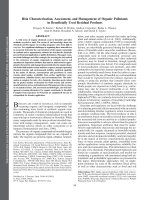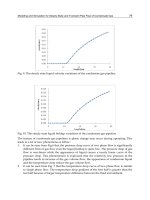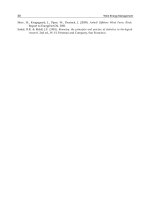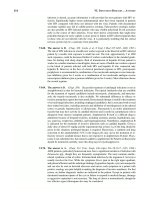Management of Organic Waste Part 4 pdf
Bạn đang xem bản rút gọn của tài liệu. Xem và tải ngay bản đầy đủ của tài liệu tại đây (655.99 KB, 15 trang )
Vermicomposting: Composting with Earthworms to Recycle Organic Wastes
37
decreases in microbial activity were reported in casts of Eu. eugeniae and E. fetida fed on pig
and cow manures respectively (Aira et al., 2006; Aira & Domínguez, 2009).
Fig. 7. Changes in microbial activity assessed by fluorescein diacetate hydrolysis, after the
passage of cow manure through the gut of the earthworm species Eisenia andrei. Values are
means ± SE. Control is the manure incubated without earthworms.
4.2 How does the earthworm species affect microbial communities?
Earthworms of different functional groups, or even different species within the same
functional group, have a particular mode of food selection, ingestion, digestion, assimilation
and movement, thus their importance in mixing, decomposition or nutrient release, as well
as in the structure and activity of microbial communities will vary both qualitatively and
quantitatively (Curry & Schmidt, 2007). To determine how the earthworm species shape the
relationships between earthworms and microorganisms during the active phase of
vermicomposting, we performed an experiment with mesocosms filled with cow manure
and inoculated with 10 mature individuals of the earthworm species Eisenia andrei, Eisenia
fetida and Perionyx excavatus. The mesocosms consisted of 2 L plastic containers filled to
three quarters of their capacity with sieved, moistened vermiculite. A plastic mesh was
placed over the surface of the vermiculite and 200 g (fresh weight, fw) of the substrate was
placed on top of the mesh, to avoid mixing the substrate with the vermiculite bedding. The
mesocosms were covered with perforated lids and stored in random positions in an
incubation chamber, at 20 °C and 90% relative humidity. Control mesocosms consisted of
each type of manure incubated without earthworms. Each treatment was replicated three
times. The length of the active phase depends greatly on the rates at which the earthworms
ingest and process the substrate (Domínguez et al., 2010). The high rate of consumption,
digestion and assimilation of organic matter by these earthworm species resulted in the
substrates being completely processed by the earthworms in one month, as previously
shown by Lores et al. (2006). After this time (i.e., active phase), the earthworms were
removed from the mesocosms and the processed material was collected from the surface of
the vermiculite. The same amount of sample was also collected from the control mesocosms.
Management of Organic Waste
38
The viable microbial biomass was assessed as the sum of all identified PLFAs and certain
PLFAs were used as biomarkers to determine the presence and abundance of specific
microbial groups. Microbial community function was determined by measuring the
bacterial and fungal growth rates. Bacterial growth was estimated by the incorporation of
radioactively labelled leucine into proteins (Bååth, 1994), as modified by Bååth et al. (2001);
fungal growth was estimated by the incorporation of radioactively labelled acetate into the
fungal-specific lipid ergosterol Newell & Fallon (1991), with modifications by Bååth (2001).
Total microbial activity was also assessed by measuring the rate of evolution of CO
2
. The
data were analyzed by a one-way ANOVA test. Post hoc comparisons of means were
performed by a Tukey HSD test, at α = 0.05.
4.2.1 Microbial biomass
The viable microbial biomass was about 3.8 times lower in the presence of E. andrei than that
in the control (Figure 8), while no such pronounced decrease was detected in relation to the
activity of E. fetida and P. excavatus (Figure 8). Similarly, the activity of E. andrei drastically
reduced the bacterial and fungal biomass in cow manure, relative to the control (3.7 and 5.3
times, respectively), after the active phase of vermicomposting (Figure 9).
In the present study, the earthworm species E. andrei could have reduced the abundance of
these microbial groups directly through ingestion, digestion and assimilation in the gut,
and/or indirectly by accelerating the depletion of resources for the microbes, since greater
losses of carbon were found as a result of earthworm activity after the active phase of
vermicomposting (data not shown). However, the second explanation seems more likely to
justify the reduction in fungal populations, since no significant changes were found in this
microbial group after the passage through the gut of E. andrei (see experiment 1).
Fig. 8. Changes in the viable microbial biomass, measured as total PLFAs, of cow manure
after being processed by the epigeic earthworm species Eisenia andrei, Eisenia fetida and
Perionyx excavatus during the active phase of vermicomposting. Values are means ± SE.
Control is the manure incubated without earthworms.
Vermicomposting: Composting with Earthworms to Recycle Organic Wastes
39
Fig. 9. Changes in (a) bacterial biomass calculated as the sum of the bacterial PLFA markers:
i14:0, i15:0, a15:0, i16:0, i17:0, a17:0, 10Me16:0, 10Me17:0, 10Me18:0, 16:1ω7, 18:1ω7, cy17:0
and cy19:0, and (b) PLFA 18:2ω6c, a measure of fungal biomass, of cow manure after being
processed by the epigeic earthworm species Eisenia andrei, Eisenia fetida and Perionyx
excavatus during the active phase of vermicomposting. Values are means ± SE. Control is the
manure incubated without earthworms.
4.2.2 Microbial activity
E. andrei reduced the bacterial growth rate by approximately 1.5 times relative to the control
without earthworms after the active phase of vermicomposting (Figure 10a); no significant
differences were detected with E. fetida and P. excavatus (Figure 10a). Despite the consistent
effects on bacterial growth, earthworm activity did not affect the fungal growth rate (data
not shown). Microbial activity in cow manure followed the same pattern as the bacterial
Management of Organic Waste
40
growth rate (Figure 10b). As mentioned before, bacteria constitute the largest fraction of the
microbiota in animal manures, and they are therefore expected to contribute greatly to the
respiration rate.
Fig. 10. Changes in (a) bacterial growth rate, estimated as leucine uptake and (b) microbial
activity, measured as basal respiration, of cow manure after being processed by the epigeic
earthworm species Eisenia andrei, Eisenia fetida and Perionyx excavatus during the active phase
of vermicomposting. Values are means ± SE. Control is the manure incubated without
earthworms.
The above-mentioned results highlight the potential of E. andrei for biodegrading organic
substrates. The species E. andrei and E. fetida are closely related, although E. andrei
predominates in mixed cultures, especially when there is no substrate limitation, as
Vermicomposting: Composting with Earthworms to Recycle Organic Wastes
41
occurred in this experiment, indicating that it is a more extreme r strategist than E. fetida, as
shown by more rapid growth and reproduction (Domínguez et al., 2005).
4.3 How do earthworms affect microbial communities of a plant residue in the short-
term?
In this study we evaluated the effectiveness of the active phase of vermicomposting for the
short-term stabilization of grape marc, a lignocellulosic enriched residue that consists of the
stalks, skin, pulp and seeds remaining after the grape crushing and pressing stages in wine
production (Flavel et al., 2005). This by-product is a valuable resource as a soil fertilizer with
high contents of macro- and micronutrients for crop growth (Bertran et al., 2004). However,
the overproduction of grape marc – more than 750,000 ton per year in Spain (Fernández-
Bayo et al., 2007) – has become a problem that requires strategies for its disposal and/or
management. Whilst composting has been widely used for the treatment of winery wastes
(Bertran et al., 2004; Marhuenda-Egea et al., 2007; Fernández et al., 2008; Bustamante et al.,
2009; Paradelo et al., 2010), there are still very few studies on the application of
vermicomposting as a methodological alternative to recycling such wastes (Nogales et al.,
2005; Romero et al., 2007, 2010).
The vermicomposting of grape marc was performed in mesocosms that consisted of plastic
containers (2 L), which were filled to three quarters of the capacity with moistened (80%
moisture content) and mature vermicompost in order to ensure the survival of the
earthworms. Five hundred juvenile and adult specimens of the epigeic earthworm species
Eisenia andrei were placed on the surface of the vermicompost. One kilogram (fresh weight)
of grape marc was placed on a mesh on the surface of the vermicompost and was rewetted
by spraying it with 20mL of tap water. The mesocosms were covered with perforated lids
and stored in random positions in an incubation chamber, at 20 °C and 90% relative
humidity. Control mesocosms consisted of the grape marc incubated without earthworms.
Each treatment was replicated five times. The high density of earthworms used and the
relatively rapid gut transit time of the epigeic earthworm species E. andrei, around 2.5–7 h,
resulted in the grape marc being completely processed by the earthworms in 15 days. After
this time (i.e., active phase), the earthworms were removed from the mesocosms and the
processed material was collected from the surface of the vermicompost bedding. The same
amount of sample was also collected from the control mesocosms. The viable microbial
biomass was assessed as the sum of all identified PLFAs and certain PLFAs were used as
biomarkers to determine the presence and abundance of specific microbial groups.
Microbial community function was determined by measuring the total microbial activity
assessed by basal respiration, and by determining the activity of enzymes involved in C and
N cycles, i.e. protease and cellulase activities.
4.3.1 Microbial biomass
Earthworm activity reduced the viable microbial biomass measured as total PLFAs relative
to the control without earthworms (96.90 ± 1.04 µg mL
-1
and 113.60 ± 1.04 µg mL
-1
for
treatments with and without earthworms). Similarly, the presence of earthworms also
reduced the abundance of both bacteria and fungi after the active phase of vermicomposting
of grape marc (Figure 11).
Management of Organic Waste
42
Fig. 11. Changes in (a) bacterial biomass calculated as the sum of the bacterial PLFA
markers: i14:0, i15:0, a15:0, i16:0, i17:0, a17:0, 16:1ω7, 17:1ω7, cy17:0 and cy19:0, and (b)
PLFAs 18:1ω9c and 18:2ω6c, a measure of fungal biomass, of grape marc after being
processed by the epigeic earthworm species Eisenia andrei during the active phase of
vermicomposting. Values are means ± SE. Control is the grape marc incubated without
earthworms.
4.3.2 Microbial activity
As occurred in the two previous experiments, the total microbial activity measured as basal
respiration was about 1.7 times lower in the presence of E. andrei than that in the control
without earthworms (Figure 12). This suggests that the presence of earthworms favoured
the stabilization of the residue, as shown by Lazcano et al. (2008). These authors found that
Vermicomposting: Composting with Earthworms to Recycle Organic Wastes
43
both vermicomposting treatments (vermicomposting and a combination of composting and
vermicomposting) produced more stabilized substrates than the active phase of composting
in terms of microbial activity.
Fig. 12. Changes in microbial activity assessed by basal respiration of grape marc after being
processed by the epigeic earthworm species Eisenia andrei during the active phase of
vermicomposting. Values are means ± SE. Control is the grape marc incubated without
earthworms.
The study of enzyme activities has been shown to be a reliable tool for characterizing the
state and evolution of the organic matter during vermicomposting (Benítez et al., 2005), as
they are implicated in the biological and biochemical processes that transform organic
wastes into stabilized products. In the present study, earthworm activity greatly reduced the
activities of the protease (Figure 13a) and cellulase enzymes (Figure 13b) in comparison with
the control. These findings are in agreement with microbial activity data, which reinforces
that a higher degree of stability was reached after the active phase of vermicomposting.
Similarly, Lazcano et al. (2008) reported lower values of protease activity, relative to the
control, after vermicomposting and composting with subsequent vermicomposting (3 and
4.4 times lower, respectively). However, they did not find any differences in relation to this
enzyme activity after the active phase of composting, indicating that the vermicomposted
materials were significantly more stabilized than the compost.
Management of Organic Waste
44
Fig. 13. Changes in (a) protease activity, and (b) cellulase activity of grape marc after being
processed by the epigeic earthworm species Eisenia andrei during the active phase of
vermicomposting. Values are means ± SE. Control is the grape marc incubated without
earthworms.
5. Conclusions
Detritivorous earthworms interact intensively with microorganisms during
vermicomposting, thus accelerating the stabilization of organic matter and greatly
modifying its physical and biochemical properties. Digestion of the ingested material is the
first step in earthworm-microorganism interactions. Passage of organic material through the
Vermicomposting: Composting with Earthworms to Recycle Organic Wastes
45
gut of epigeic earthworms reduced the viable microbial biomass and affected the abundance
of bacteria to a greater extent than fungi. Microbial activity also decreased after transit of the
microorganisms through the earthworm gut. Accordingly, the presence of earthworms
reduced microbial biomass and activity after the active phase of vermicomposting, although
this effect depended on the earthworm species involved. The bacterial growth rate also
decreased in the substrate, whereas the fungal growth rate was not affected after one month.
The speed at which these transformations occurred made the active phase of
vermicomposting a suitable stage for studying the relationships between earthworms and
microorganisms and permitted us to understand the chemical and biological consequences
of earthworm activities. Ultimately, these findings provide valuable information for the
understanding of the transformations that organic matter undergoes during
vermicomposting and, in addition constitute a powerful tool for the development of
strategies leading to a more efficient process for the disposal and/or management of organic
wastes.
6. Acknowledgments
This research was financially supported by the Spanish Ministerio de Ciencia e Innovación
(CTM2009-08477). María Gómez Brandón is financially supported by a postdoctoral
research grant from Fundación Alfonso Martín Escudero.
7. References
Adam, G. & Duncan, H. (2001). Development of a Sensitive and Rapid Method for the
Measurement of Total Microbial Activity Using Fluorescein Diacetate (FDA) in a
Range of Soils. Soil Biology and Biochemistry, vol. 33, No. 7-8, pp. 943-951, ISSN 0038-
0717.
Aira, M., Monroy, F. & Domínguez, J. (2006). Changes in Microbial Biomass and Microbial
Activity of Pig Slurry After the Transit Through the Gut of the Earthworm Eudrilus
eugeniae (Kinberg, 1867). Biology and Fertility of Soils, vol. 42, No. 4, pp. 371–376,
ISSN 0178-2762.
Aira, M., Monroy, F. & Domínguez, J. (2007). Eisenia fetida (Oligochaeta: Lumbricidae)
Modifies the Structure and Physiological Capabilities of Microbial Communities
Improving Carbon Mineralization During Vermicomposting of Pig Manure.
Microbial Ecology, vol. 54, No. 4, pp. 662-671, ISSN 0095-3628.
Aira, M. & Domínguez, J. (2008). Optimizing Vermicomposting of Animal Wastes: Effects of
Dose of Manure Application on Carbon Loss and Microbial Stabilization. Journal of
Environmental Management, vol. 88, No. 4, pp. 1525-1529, ISSN 0301-4797.
Aira, M.; Sampedro, L.; Monroy, F. & Domínguez, J. (2008). Detritivorous Earthworms
Directly Modify the Structure, thus Altering the Functioning of a Microdecomposer
Food Web. Soil Biology and Biochemistry, vol. 40, No. 10, pp. 2511-2516, ISSN 0038-
0717.
Aira, M. & Domínguez, J. (2009). Microbial and Nutrient Stabilization of Two Animal
Manures After the Transit Through the Gut of the Earthworm Eisenia fetida
(Savigny, 1826). Journal of Hazardous Materials, vol. 161, No. 2-3, pp. 1234-1238, ISSN
0304-3894.
Management of Organic Waste
46
Aira, M.; Monroy, F. & Domínguez, J. (2009). Changes in Bacterial Numbers and Microbial
Activity of Pig Slurry during Gut Transit of Epigeic and Anecic Earthworms.
Journal of Hazardous Materials, vol. 162, No. 2-3, pp. 1404-1407, ISSN 0304-3894.
Aira, M. & Domínguez, J. (2011). Earthworm Effects without Earthworms: Inoculation of
Raw Organic Matter with Worm-Worked Substrates Alters Microbial Community
Functioning. Plos One, vol. 6, No. 1, pp. 1-8, ISSN 1932-6203.
Bååth, E. (1994). Measurement of Protein Synthesis by Soil Bacterial Assemblages with the
Leucine Incorporation Technique. Biology and Fertility of Soils, vol. 17, No. 2, pp.
147–153, ISSN 0178-2762.
Bååth, E. (2001). Estimation of Fungal Growth Rates in Soil Using
14
C-Acetate Incorporation
into Ergosterol. Soil Biology and Biochemistry, vol. 33, No. 14, pp. 2011–2018, ISSN
0038-0717.
Bååth, E.; Petterson, M. & Söderberg, K.H. (2001). Adaptation of a Rapid and Economical
Microcentrifugation Method to Measure Thymidine and Leucine Incorporation by
Soil Bacteria. Soil Biology and Biochemistry, vol. 33, No. 11, pp. 1571-1574, ISSN 0038-
0717.
Bardgett, R.A. & Wardle, D.A. (2010). Aboveground-Belowground Linkages, Oxford University
Press, ISBN 978-0-19-954687-9, New York.
Benítez, E.; Sanz,H. & Nogales, R. (2005). Hydrolytic Enzyme Activities of Extracted Humic
Substances During the Vermicomposting of a Lignocellulosic Olive Waste,
Bioresource Technology vol. 96, No. 7, pp. 785–90, ISSN 0960-8524.
Bertran, E.; Sort, X.; Soliva, M. & Trillas, I. (2004). Composting of Winery Waste: Sledges and
Grape Stalks. Bioresource Technology, vol. 95, No. 2, pp. 203–208, ISSN 0960-8524.
Bustamante, M.A.; Paredes, C.; Morales, J.; Mayoral, A.M. & Moral, R. (2009). Study of the
Composting Process of Winery and Distillery Wastes Using Multivariate
Techniques. Bioresource Technology, vol. 100, No. 20, pp. 4766–4772, ISSN 0960-8524.
Curry, J.P. & Schmidt, O. (2007). The Feeding Ecology of Earthworms – a Review.
Pedobiologia, vol. 50, No. 6, pp. 463–477, ISSN 0031-4056.
Darwin, C . (1881) The Formation of Vegetable Mould through the Action of Worms with
Observations on their Habits, Murray, London.
De Boer, W.; Folman, L.B.; Summerbell, R.C. & Boddy, L. (2005). Living in a Fungal World:
Impact of Fungi on Soil Bacterial Niche Development. FEMS Microbiology Reviews,
vol. 29, No. 4, pp. 795-811, ISSN 1574-6976.
Domínguez, J. (2004). State of the Art and New Perspectives on Vermicomposting Research,
In: Earthworm Ecology, C.A. Edwards, (Ed.), 401-424, CRC Press, ISBN 1-884015-74-
3, Boca Raton, Florida.
Domínguez, J.; Ferreiro, A. & Velando, A. (2005). Are Eisenia fetida (Savigny, 1826) and
Eisenia andrei Bouché, 1972 (Oligochaeta, Lumbricidae) Different Biological Species?
Pedobiologia, vol. 49, pp. 81-87, ISSN 0031-4056.
Domínguez, J. & Edwards, C.A. (2010a). Relationships between Composting and
Vermicomposting: Relative Values of the Products, In: Vermiculture Technology:
Earthworms, Organic Waste and Environmental Management, C.A. Edwards; N.Q.
Arancon; R.L. Sherman, (Eds.), 1-14, CRC Press, ISBN 9781439809877, Boca Raton,
Florida.
Domínguez, J. & Edwards, C.A. (2010b). Biology and Ecology of Earthworm Species Used
for Vermicomposting, In: Vermiculture Technology: Earthworms, Organic Waste and
Vermicomposting: Composting with Earthworms to Recycle Organic Wastes
47
Environmental Management, C.A. Edwards; N.Q. Arancon; R.L. Sherman, (Eds.), 25-
37, CRC Press, ISBN 9781439809877, Boca Raton, Florida.
Domínguez, J.; Aira, M. & Gómez-Brandón, M. (2010). Vermicomposting: Earthworms
Enhance the Work of Microbes, In: Microbes At Work: From Wastes to Resources, H.
Insam; I. Franke-Whittle; M. Goberna, (Eds.), 93-114, Springer, ISBN 978-3-642-
04042-9, Heidelberg, Germany.
Drake, H.L. & Horn, M.A. (2007). As the Worm Turns: the Earthworm Gut as a Transient
Habitat for Soil Microbial Biomes. Annual Review of Microbiology, vol. 61, pp. 169-
189, ISSN 0066-4227.
Edwards, C.A. & Bohlen, P.J. (1996). Biology and Ecology of Earthworms, Chapman and Hall,
London.
Flavel, T.C., Murphy, D.V., Lalor, B.M., & Fillery, I.R.P. (2005). Gross N Mineralization Rates
after Application of Composted Grape Marc of Soil. Soil Biology and Biochemistry,
vol. 37, No. 7, pp. 1397–1400, ISSN 0038-0717.
Fernández-Bayo, J.D.; Nogales, R. & Romero, E. (2007). Improved Retention of Imidacloprid
(Confidor®) in Soils by Adding Vermicompost from Spent Grape Marc. Science of
Total Environment, vol. 378, No. 1-2, pp. 95–100, ISSN 0048-9697.
Fernández, F.J.; Sánchez-Arias, V.; Villaseñor, J. & Rodríguez, L. (2008). Evaluation of
Carbon Degradation during Co-composting of Exhausted Grape Marc with
Different Biowastes. Chemosphere, vol. 73, No. 5, pp. 670-677, ISSN 0045-6535.
Gómez-Brandón, M.; Aira, M.; Lores, M. & Domínguez, J. (2011a). Epigeic Earthworms Exert
a Bottleneck Effect on Microbial Communities through Gut Associated Processes.
Plos One, vol. 6, No. 9, pp.1-9, ISSN 1932-6203.
Gómez-Brandón, M.; Aira, M.; Lores, M. & Domínguez, J. (2011b). Changes in Microbial
Community Structure and Function During Vermicomposting of Pig Slurry.
Bioresource Technology, vol. 102, No. 5, pp. 4171-4178, ISSN 0960-8524.
Hutchinson, M.L.; Walters, L.D.; Avery, S.M.; Munro, F. & Moore, A. (2005). Analyses of
Livestock Production, Waste Storage, and Pathogen Levels and Prevalences in
Farm Manures. Applied and Environmental Microbiology, vol. 71, No. 3, pp. 1231-1236,
ISSN 1098-5336.
Lazcano, C.; Gómez-Brandón, M. & Domínguez, J. (2008). Comparison of the Effectiveness
of Composting and Vermicomposting for the Biological Stabilization of Cattle
Manure. Chemosphere, vol. 72, No. 7, pp. 1013-1019, ISSN 0045-6535.
Lores, M.; Gómez-Brandón, M.; Pérez-Díaz, D. & Domínguez, J. (2006). Using FAME profiles
for the Characterization of Animal Wastes and Vermicomposts. Soil Biology and
Biochemistry, vol. 38, No. 9, pp. 2993-2996, ISSN 0038-0717.
Marhuenda-Egea, F.C.; Martínez-Sabater, E.; Jordá, J.; Moral, R.; Bustamante, M.A.; Paredes,
C. & Pérez-Murcia, M.D. (2007). Dissolved Organic Matter Fractions Formed
during Composting of Winery and Distillery Residues: Evaluation of the Process by
Fluorescence Excitation–Emission Matrix. Chemosphere, vol. 68, No. 2 pp. 301–309,
ISSN 0045-6535.
Monroy, F.; Aira, M. & Domínguez, J. (2008). Changes in Density of Nematodes, Protozoa
and Total Coliforms after Transit through the Gut of Four Epigeic Earthworms
(Oligochaeta). Applied Soil Ecology, vol. 39, No. 2, pp. 127–132, ISSN 0929-1393.
Monroy, F.; Aira, M. & Domínguez, J. (2009). Reduction of Total Coliform Numbers during
Vermicomposting is Caused by Short-term Direct Effects of Earthworms on
Management of Organic Waste
48
Microorganisms and Depends on the Dose of Application of Pig Slurry. Science of
the Total Environment, vol. 407, No. 20, pp. 5411-5416, ISSN 0048-9697.
Monroy, F.; Aira, M. & Domínguez, J. (2011). Epigeic Earthworms Increase Soil Arthropod
Populations during First Steps of Decomposition of Organic Matter. Pedobiologia,
vol. 54, No. 2, pp. 93-99, ISSN 0031-4056.
Moore, J.C.; Berlow, E.L.; Coleman, D.C.; de Ruiter, P.C.; Dong, Q.; Johnson, N.C.; McCann,
K.S.; Melville, K.; Morin, P.J.; Nadelhoffer, K.; Rosemond, A.D.; Post, D.M.; Sabo,
J.L.; Scow, K.M.; Vanni, M.J. & Wall, D.H. (2004). Detritus, Trophic Dynamics and
Biodiversity. Ecology Letters, vol. 7, pp. 584–600.
Moral, R.; Paredes, C.; Bustamante, M.A.; Marhuenda-Egea, R. & Bernal, M.P. (2009).
Utilisation of Manure Composts by High-Value Crops: Safety and Environmental
Challenges. Bioresource Technology, vol. 100, No. 22, pp. 5454-5460, ISSN0960-8524.
Newell, S.Y. & Fallon, R.D. (1991). Toward a Method for Measuring Instantaneous Fungal
Growth Rates in Field Samples. Ecology, vol. 72, No. 5, pp. 1547–1559, ISSN 0012-
9658.
Nogales, R.; Cifuentes, C. & Benítez E. (2005). Vermicomposting of Winery Wastes: a
Laboratory Study. Journal of Environmental Science and Health Part B vol. 40, No. 4,
pp. 659-673, ISSN 0360-1234.
Paradelo, R.; Moldes, A. & Barral, M. (2010). Utilization of a Factorial Design to Study the
Composting of Hydrolyzed Grape Marc and Vinification Lees. Journal of Agriculture
and Food Chemistry, vol. 58, No. 5, pp. 3085–3092.
Reynolds, J. W. & Wetzel, M. J. (2010). Nomenclatura Oligochaetologica. Supplementum
Quartum. A catalogue of names, descriptions and type specimens of the Oligochaeta,
Illinois Natural History Survey Special Publication, Chicago.
Romero, E.; Plaza, C.; Senesi, N.; Nogales, R. & Polo, A. (2007). Humic Acid-Like Fractions
in Raw and Vermicomposted Winery and Distillery Wastes. Geoderma, vol. 139, No.
3-4, pp. 397-406, ISSN 0016-7061.
Romero, E.; Fernández-Bayo, J; Díaz, J.M.C. & Nogales, R. (2010). Enzyme Activities and
Diuron Persistence in Soil Amended with Vermicompost Derived from Spent
Grape Marc and Treated with Urea. Applied Soil Ecology, vol. 44, No. 3, pp.198-204,
ISSN 0929-1393.
Schönholzer, F.; Dittmar, H. & Zeyer, J. (1999). Origins and Fate of Fungi and Bacteria in the
Gut of Lumbricus terrestris L. Studied by Image Analysis. FEMS Microbiology
Ecology, vol. 28, No. 3, pp. 235-248, ISSN 1574-6941.
Zelles, L. (1997). Phospholipid Fatty Acid Profiles in Selected Members for Soil Microbial
Communities. Chemosphere, No. 1-2, vol. 35, pp. 275–294, ISSN 0045-6535.
Zelles, L. (1999). Fatty Acid Patterns of Phospholipids and Lipopolysaccharides in the
Characterization of Microbial Communities in Soil: a Review. Biology and Fertility of
Soils, vol. 29, No. 2, pp. 111–129, ISSN 0960-8524.
Zhang, B.; Li, G.; Shen, T.; Wang, J. & Sun, Z. (2000). Changes in Microbial Biomass C, N,
and P and Enzyme Activities in Soil Incubated with the Earthworms Metaphire
guillelmi or Eisenia fetida. Soil Biology and Biochemistry, vol. 32, No. 2, pp. 2055-2062,
ISSN 0038-0717.
3
The Sanitation of Animal Waste
Using Anaerobic Stabilization
Ingrid Papajová and Peter Juriš
Institute of Parasitology of the
Slovak Academy of Sciences
Slovak Republic
1. Introduction
Animal production pose potential hazards of environmental contamination with pathogenic
microorganisms. These are particularly related to a subsequent storage processing and
utilization of animal organic wastes (manure, fertilizer, wastewater, sludges etc.). A major
source of pathogenic microorganisms in the environment are excrements from clinically and
subclinically infected farm animals.
Handling, storage, treatment and use of different forms of animals excrements entails two
principle problems: epizootological or epidemiological and hygienical. Solid excrements
contain high numbers of common intestinal microflora (E. coli, faecal streptococci,
lactobacilli etc.), bacteria that are pathogenic also for man (salmonellae, mycobacteria,
listeriae etc.), protozoa (Isospora spp., Balantidium coli) and eggs or larvae of
enteronematodes (Ascaris suum, Oesophagostomum sp., Trichuris suis etc.) (Lauková et al.,
2000; Krupicer et al., 2000).
The parasitic propagative stages, mainly endoparasitic protozoa and helminths develop
mostly outside their host´s organism. A. suum eggs are hygienically the most problematic
ones. They are amongst the helminth eggs most resistant to environmental factors and may
survive in the nature for many years, therefore, they tend to accumulate in the environment
(soil, water) and serve as an infectious entity for both man and animals (Papajová and Juriš,
2009). The cell wall of A suum egg is enveloped with an outer layer formed by acid
polysaccharides and proteins, central layer consisting of proteins (25%) and lipids (75%,
particularly alpha glycosides). Thus this resistant cell wall protects eggs against effects of
chemicals and drying (Eckert, 1992).
Regarding the spread of helminthoses, domestic animals (dogs, cats) are also of great
importance because they live in a close contact with man. Infection and way of transmission
of the disease depends on the way of breeding and on the breeding environment where the
animal occurs. An important factor of the risk of infection transmission is also possibility of
animal to move outside its housing (yard, move in nature), or the use of a dog (hunting or
social). The most frequent way of transmission of parasitic diseases is through the contact
(free-living animals with a domestic ones), or through contaminated environment with
Management of Organic Waste
50
developmental stages (oocysts, eggs, larvae). Through faeces of infected dogs and cats the
germs of parasitozoonoses spread into the environment. It is especially the case of cysts of
intestinal parasitic protozoa – Entamoeba histolytica, Giardia intestinalis, Balantidium coli,
Toxoplasma gondii, the eggs of tapeworms Dipylidium sp., Echinococcus sp. and parasitic
nematodes (Antolová et al., 2004; Matsuo and Nakashio, 2005; Miterpáková et al., 2006).
Regarding public health helminthozoonoses caused by Toxocara sp. (in dogs) and Ascaris sp.
(in pigs) are very significant, especially due to their zoonotic character connected with the
syndrome larva migrans.
Humans became infected usually orally (per os) by ingestion of substrates (soil, vegetables,
etc.) with embryonated Toxocara eggs. Many symptoms are associated with this infection,
including changes in blood cell counts and affection of various organs, as the ascaris larvae
can migrate throughout the body. The symptoms of infection are often non-specific and may
be mistaken with those of other infectious agents (common viral diseases, diarrhoea) or we
may not observe any clinical signs. Toxocariasis manifests itself in two distinct forms:
visceral, larva migrans visceralis, and ocular, larva migrans ocularis (Despommier, 2003).
A. suum infects pigs and is of major economical significance due to production losses linked
to reduced feed conversion efficiency and losses to the mean industry associated with the
condemnation of “milk-spot” livers (Dubinský et al., 2000). Ascaris infects over a quarter of
the world´s human population (1.47 billion people worldwide) and clinically affects ~335
million people (Crompton, 1999).
The above-mentioned helminthozoonoses are classified among epidemiologically ”low-risk”
parasitozoonoses, because the propagative stages develop in the outdoor environment into
the infectious stage and potentially secondarily contaminate the food chain. Therefore, a
direct contact with infected animal, but also contaminated environment, or contaminated
food chain (water, vegetables) are considered as a potential risk factor.
Attention has receantly been paid also to the problem of hygienical hazards in terms of the
treatment and use of animal excrements and their application to soil as valuable nutrients
for cultivated plants. The hazards are mainly connected with the quantity of continually
produced solid and liquid wastes. The results is ecological disbalance, mainly with respect
to environmental load with pathogenic microorgamism and nitrous organic substances.
Animal organic wastes are also sources of greate amounts of gases releases. The most
dangerous of them are ammonia and methane. Ammonia released into the atmosphere is
irritating and toxic to the biotic component of the environment. On the other hand, animal
excrements can supply essential plant nutrients and improve the fertility of soil by adding
organic matter.
Therefore, to prevent health risks (for human as well as for animals) and odour nuisance
from animal wastes, different methods for a satisfactory utilisation and sanitation have been
researched (Schwartzbrod et al., 1989, Tofant et al., 1999; Juriš et al., 2000; Sasáková et al.,
2005; Papajová and Juriš, 2009). There are big variations in the treatment of animal wastes
(aerobic and anaerobic stabilization, composting etc.).
For the above-mentioned reasons our studies concentrated on anaerobic stabilization of
liquid (slurry) and solid (manure, excrements) animal waste. The aims of our study were to









